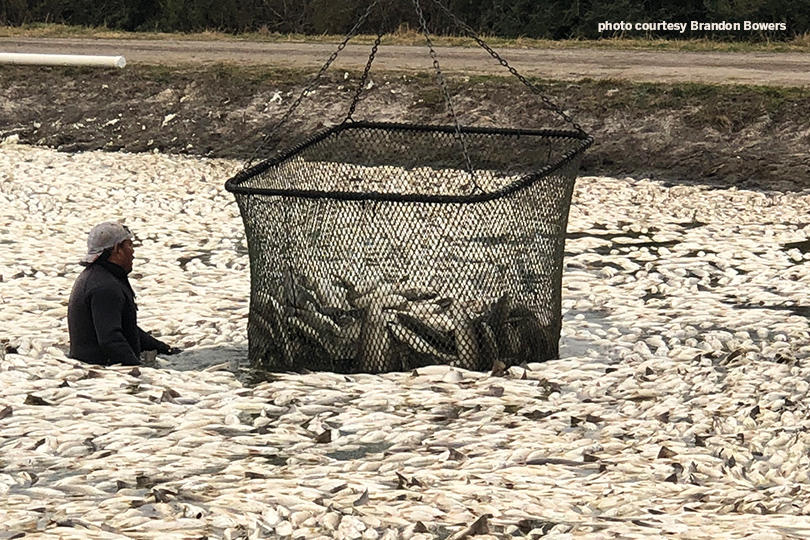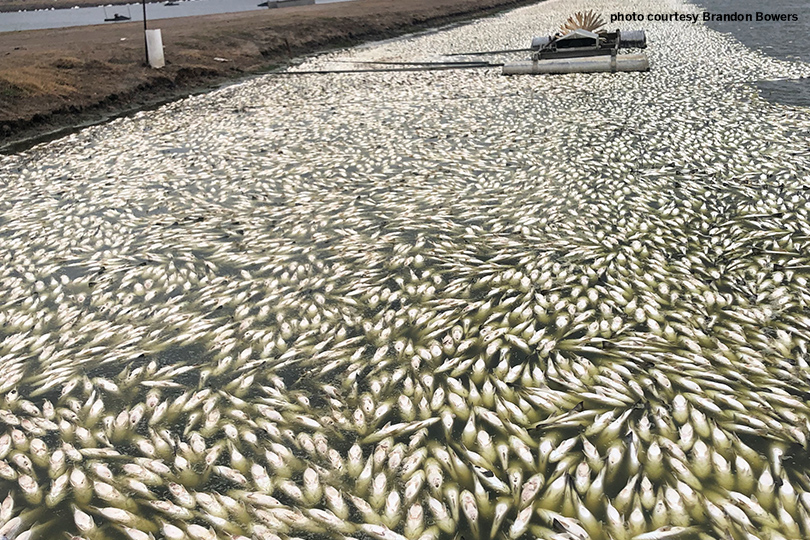By Julie Tomascik
Editor
A strong business plan, a leap of faith and a background in raising fish couldn’t prepare Brandon Bowers for the unprecedented and unpredictable challenges he’d face in 2020 and 2021.
The COVID-19 pandemic and February’s winter storm devastated his business.
The two combined into the perfect, yet awful, storm, leaving his new aquaculture farm to face an uncertain future.
“I started my farm about two-and-a-half years ago, but I’ve been involved in aquaculture pretty much my entire life,” he said. “I grew up in it, and I’ve always had a passion for it. My wife and I decided we wanted to raise our five kids on the farm, so we started Texas Mariculture.”
They’re located near Palacios, a small town on the Gulf Coast between Houston and Corpus. They raise red drum, also known as redfish.
Growing conditions for farm-raised redfish are ideal in the Gulf Coast area. That is until Winter Storm Uri ushered in freezing and below-freezing temperatures for five consecutive days in February.
The impact? Complete devastation.
Many aquaculture farms suffered major fish losses, but redfish farmers like Bowers were severely impacted.
“In an effort to save the fish, we installed heaters into specifically constructed refuge areas, which were built and designed to mitigate losses due to a freeze,” Bowers, a Matagorda County Farm Bureau member, said. “Unfortunately, all efforts and improvements could not overcome the brutal forces of the arctic freeze.”
His biggest fear became a reality when he lost his entire crop after two-and-a-half years of hard work.
“My first marketable crop and a new fingerling crop were lost within a matter of days,” he said. “I was in shock. You hear about people losing everything, but you don’t know what it’s like until you’re living it. This is my livelihood, and I don’t know what to do next.”
He’s not alone.
Farmers report about 99 percent of the domestic redfish supply was lost to February’s freeze.
And in a state that’s known as the redfish capital and the largest supplier of redfish in the United States, it’s an overwhelming blow to the industry. This species is a premier fresh fish item on the menu at many restaurants in southern states, but supplies will lack this year following the storm.
“Every redfish farmer was impacted, and many aquaculture farmers felt some kind of impact from this freeze,” he said.
Farmers and farmworkers have spent the days since the storm cleaning up dead fish from the ponds, but the future is uncertain.

Because of a definition in the U.S. Department of Agriculture’s (USDA) Emergency Assistance for Livestock, Honey Bees and Farm-raised Fish (ELAP), redfish is not considered an eligible commodity for disaster assistance.
USDA classifies redfish as a fin fish, rather than a game fish, which excludes it from the program.
“The bills don’t stop. They just keep coming in, whether it’s rent, equipment, labor, the hatchery, electric, administrative. Everything still keeps coming,” Bowers said. “Plus, we have to clean up all the dead fish in the ponds, and then also make sure we dispose of them properly and prepare for the next cycle, if there is a next cycle.”
Everything’s at stake for Bowers and many of the few remaining redfish farmers in the state.
The small group came together to advocate for assistance with the help of Texas Farm Bureau and other organizations.
“This is a very demanding industry, and not many of us redfish farmers really talked to each other a lot prior to the storm,” Bowers said. “But now we’ve reached out to one another. We’re working together, and we’ve met with Congressman Cloud. We’ve also reached out to state lawmakers about this situation.”
Without disaster aid, Bowers faces many unknowns.
“We have had many hurdles along the way, as with every new startup, but we were still on track to do well,” he said. “We chose redfish due to the increasing demand for fresh U.S. farm-raised fish and, at the time, felt improvements to freeze protection protocols reduced freeze risks associated with raising redfish. Very little redfish have been lost due to cold temperatures since the freeze of 1989.”
If they were eligible for ELAP, it still wouldn’t make the farmers whole, but it would provide them something to help move forward.
Estimates provided by the redfish farmers show there’s about $50 million worth of loss of redfish and fingerlings. A devastating blow to farmers and restaurants.
The damage, however, may not have been as severe if social distancing and shelter-in-place orders had not been implemented due to the coronavirus pandemic.
“That’s what you call a perfect storm because right now, because of COVID-19, our sales were suppressed or almost even stopped since around November. We were forced to sit on an abnormally high inventory, and not only did we sit on those, but we also continued to build as we continued to feed them. We just knew we were going to come out of this,” he said.
Bowers was feeling optimistic that he had made it through December and January, which are usually the worst months for aquaculture when the cold can stress the fish.
“The farm was sitting on and still building inventory at a time when redfish farmers are most vulnerable, but we made it through those months and stayed optimistic. Lent was coming, the COVID vaccine was here and restaurants were increasing in capacity. There was going to be a demand for our fish,” Bowers said. “Then this happened.”
It could take up to two years for redfish farmers to recover.
“COVID really magnified this issue because we sat on so much inventory. And because we lost all of our revenue for three, four months prior, that was when we took the significant hit. Now, without any assistance, the future of the redfish industry may or may not exist. We’re asking for immediate assistance so that we can continue to operate and move forward with the production of fingerlings to start over,” he said. “And in the long term, we’re looking for some kind of assistance for all aquaculture producers so that we can have more young farmers join the industry and get excited about aquaculture.”
For now, Bowers is left treading water as he awaits word from legislators and USDA about possible assistance. The future of Texas Mariculture and the Texas redfish industry remains uncertain.
Editor’s Note: USDA announced a policy change on May 13 that makes food fish and other aquatic species eligible for the Emergency Assistance for Livestock, Honey Bees and Farm-raised Fish Program (ELAP). Click here to read more about the update.

